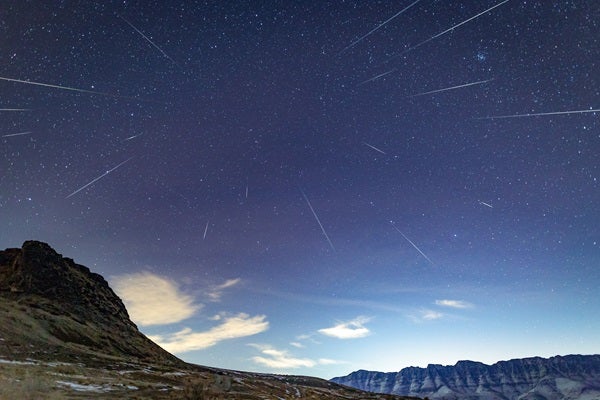The approach of the new year is an exciting time for backyard astronomers, myself included. As with years past, 2020 promises another 12 months of must-see cosmic happenings and must-attend astronomical conventions. It also brings the risk that you might wake up one day and realize that you forgot about last night’s meteor shower or astronomy club meeting. In recent years, I’ve cut down on these mishaps by creating a personalized astronomy calendar. If you want to make one of your own, here’s what to do.
Around year’s end, go to your local office supply store and purchase a 16- by 20-inch desk calendar for the new year. Once you’re back at home, fill in the various date boxes with everything astronomical that you don’t want to miss. Sounds like a tall order, but the task is easy if you follow these steps.
Begin by jotting down only the year’s key celestial events — biggies like eclipses, meteor showers, and planetary oppositions. These can be found in the special “Sky Guide 2020” pull-out at the center of this month’s issue. Once those are logged, add anything that’s of special interest to you. I note the opposition dates for asteroids I’ve yet to snare with my 3-inch f/10 reflector (Edmund Scientific’s classic Space Conqueror). Since spotting Vesta in 1971, the little scope has bagged 121. Here’s hoping I can conquer a few more in 2020!
Up next are “astro-social” dates of importance. These would include astronomy club activities, conventions, and outreach events. Are you scheduled to present a talk at an upcoming club meeting or convention? Write it in as well!
With the year mapped out, it’s time to roll up your sleeves and fill in specific details for each month. A go-to resource for these updates is the Sky This Month section, found in this and every issue of Astronomy. On the calendar’s January page, where I’ve already noted the Quadrantid meteor shower (evening of January 3/4) and a January 9 meeting of my astronomy club, I’ll add the dates and times of the Moon’s phases, as well as viewing opportunities for the planets and any currently visible comets or asteroids. I’ll cap things off by adding this month’s Observer’s Challenge to the top of the page. I wrote about this neat observing program in the January 2016 issue (“New month, new target”). For January 2020, the challenge is the reflection nebula NGC 1999 in Orion.
What celestial events will I focus on in 2020? I’ve decided that this will be the Year of the Meteor Shower. I’ll start by checking out the aforementioned Quadrantid meteors. I’ve never seen a Quadrantid meteor before, so this could be a first. Other meteor showers largely unaffected by bright moonlight will be the Lyrids (April 22/23), Perseids (August 12/13), Orionids (October 21/22), Leonids (November 17/18), and — saving the best for last — the Geminids (December 13/14). There’s nothing more relaxing than sinking into a reclining lawn chair and watching a dazzling display of nature’s fireworks.
Of course, sometimes one safety net isn’t enough. As a backup, I’ll place the 2020 edition of Astronomy’s Deep Space Mysteries calendar on the wall. With one calendar on my desk and one on my wall, it’ll be hard to miss any important dates!
On an unrelated note: Ladies, I need your help. I’m planning a women-in-astronomy-clubs-themed Observing Basics column to run in a future issue, but I need feedback from female readers who are current (or past) members of an astronomy club. What got you interested in astronomy? Why did you join an astronomy club? What can astronomy clubs do to increase their number of female members? What advice would you give to a woman considering joining an astronomy club? Your email responses (positive or negative) are welcome!
Questions, comments, or suggestions? Email me at gchaple@hotmail.com. Next month: Planning an evening observing session. Clear skies!










